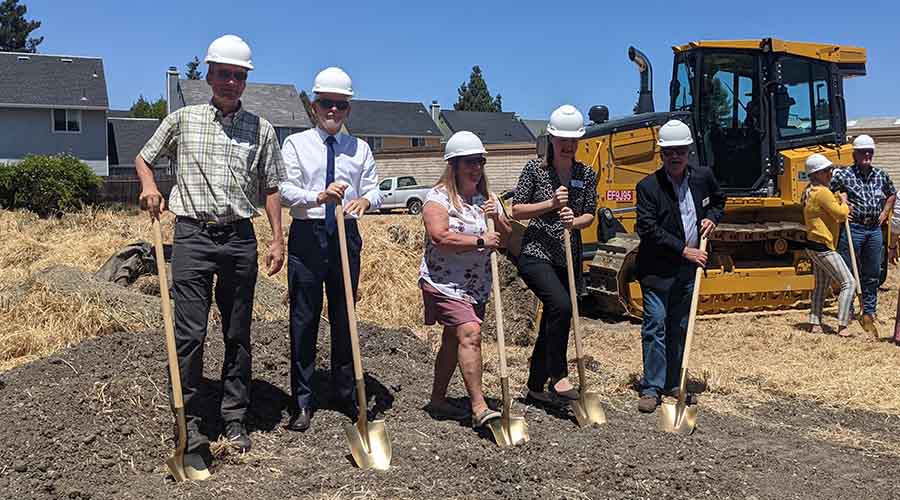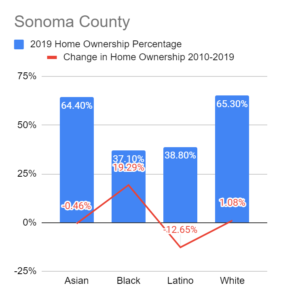
(Photo: Housing Land Trust of Sonoma County)
Ground broke this month on Jamie Lane, an affordable housing pilot project in the city of Cotati that utilizes manufactured homes, infill sites and partnerships from the local to the national level. It’s welcome news for a region with high housing costs that has also suffered the loss of housing inventory from recent wildfires and other disasters.
Jamie Lane is being developed as five single-family manufactured homes on infill property near transit for low-to-moderate income families. One of the stand-out parts of this project is that it will be designated as affordable in perpetuity, ensuring that generations of families usually priced out of the area will be able to build equity and generational wealth through homeownership.
It is the brainchild of Dev Goetschius of the Housing Land Trust of Sonoma County (HLT) and Tia Boatman Patterson, who at the time was the California Housing Finance Agency’s (CalHFA) executive director and is now with the Biden Administration as associate director for housing, treasury and commerce at the Office of Management and Budget.
“It was approved unanimously by the Board of Directors at CalHFA. The only thing the chair said was, ‘We’ve been waiting to do a land trust project,’” explained Goetschius. “It’s a long time coming. We’re going to make this investment and it’s going to be embedded in the land. Its subsidies are going to be recycled each time and we’re done. You increase the housing supply, and you don’t look back.”
The site in the City of Cotati was originally set to be a market-rate development but got caught up in the 2008-09 housing crisis. When it became bank-owned, the city realized the importance of the property, quickly bought it and started working with HLT.
 61.5% of Sonoma County residents are homeowners, 12% higher than the statewide average. 61.5% of Sonoma County residents are homeowners, 12% higher than the statewide average.
Yet substantial disparities in home ownership exist between the County’s White and Asian residents and its Black and Brown residents. Learn more through the California Dream Index here. |
|---|
“We had partnered in that transaction with Housing Land Trust with the thought that this would be an affordable project and with the HLT model,” said Cotati City Manager Damien O’Bid. “It’s a model that we really like for a lot of reasons. We’re a small city, so we don’t have a lot of staff, so monitoring the housing stock after the initial build and sale is a little more challenging for us.” Because the houses are affordable in perpetuity, there’s no need to ensure the homes will continue to be designated affordable after each sale, unlike inclusionary units in market-rate developments.
Jamie Lane is funded through:
- City of Cotati – land and entitlements,
- Sonoma County – Transient Occupancy Tax (TOT) funding from the County’s Community Development Commission
- CalHFA – funding through the purchase of affordability covenants and donated time and expertise from development partners, and
- Fannie Mae – Renew Now Homes that comply with Fannie Mae’s MH Advantage specifications, making homebuyers eligible for Fannie Mae loans.
“The unique thing about this project is that we were providing funds that none of us are really looking to get back,” said Kevin Brown, a housing finance specialist at CalHFA. “Once these monies have gone back to the land trust, as long as they stay within the terms of the regulatory agreements, they don’t have to give it back.” He estimates the contributions have reduced the homes’ purchase price by $200,000.
Brown added, “Not having to pay it back means the land trust doesn’t have a loan that they have to make debt service payments on, or they have to do a lump payment in 30 or 55 years to pay it off.”
The new Jamie Lane residents will also have access to programs that teach financial literacy, which will include building equity and saving money. O’Bid explained that they will “ideally be able to get to a place in their life where they can move out of the housing land trust home and use the equity they earned and life skills they learned to buy market–rate and stay in the community.”
Goetschius wants Jamie Lane to be a prototype for affordable housing, especially targeting regions that are recovering from disasters, have limited land supply and/or access to underutilized land and have high labor and material costs that hamper home building. “This project is really a passion project because we need to figure out another path to get ‘heads on beds’ in perpetuity.”

